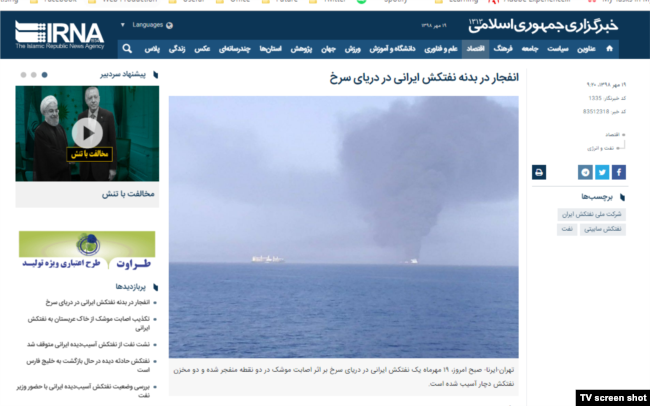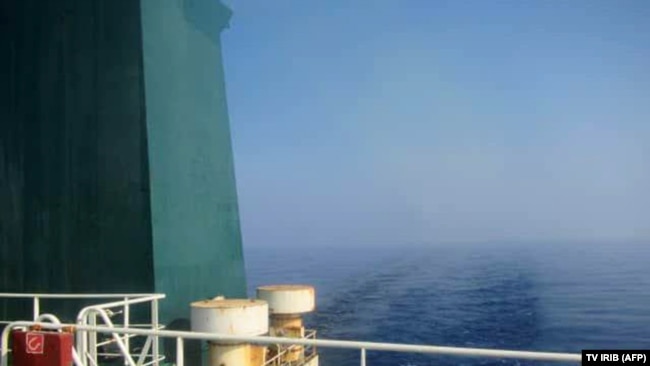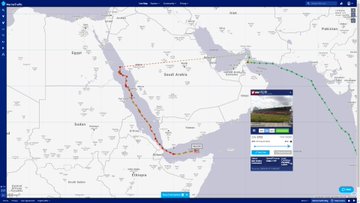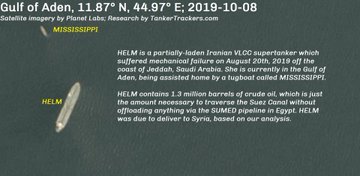Radiofarda – On Thursday October 10, Iran’s Foreign Minister Javad Zarif penned an op-ed in the Kuwaiti newspaper Al-rai. While calling for dialog between all the countries of the Persian Gulf, he also threatened all the regional foes saying that either everybody will enjoy security “or they will all be deprived of it.”
In the early morning of October 11, Iranian media began reporting that an Iranian owned tanker suffered two explosions in the Red Sea.
The international media quickly picked up rapid-fire reports from Iranian media, which soon proved to be full of contradictions, negations and even the use of photos from incidents in the past. No independent source confirmed the report and no reporters were in the middle of the Red Sea to see the “damaged” tanker.
The first report that an Iranian vessel was hit in the Red was reported by Reuters at 7:14 CET. The message read, “AN EXPLOSION IN AN IRANIAN TANKER HAS SET THE NIOC-OWNED VESSEL ON FIRE NEAR SAUDI PORT CITY OF JEDDAH – ISNA.”
Major Western agencies AP, AFP and Reuters continued to quote Iranian media outlets such as ISNA that claimed the tanker had suffered heavy damage and was leaking oil “some 60 miles from Jeddah”, according to unnamed sources.
In a report by Reuters at 8:14 CET the tanker’s name remained unknown and Reuters quoted Lt. Pete Pagano the spokesman for U.S. Navy’s 5th fleet as saying, “we are aware of reports of this incident.” It would be important to note here the spokesman acknowledged “reports” not the attack.
In a Reuters flash issued at 8:15 Iran’s National Oil Company was quoted as saying two missiles targeted oil tanker SINOPA and caused an explosion. The source of this information was Iran’s National Oil Company (NIOC) website. This was strange as several minutes later IRNA, according Reuters, identified the struck tanker as Sabiti.
The biggest issue is that NIOC was confused and wrongly identified a tanker sailing to the Suez in the northern direction and tanker Sabiti sailing to the south. Most tankers have capabilities such as satellite phones and how could the main national oil company make such a mistake.
Tanker Sabiti last had its transponders turned on in August according to the popular tanker tracking website TankerTrackers.com. As of 8:44, the only sources for the tanker attack remained Iranian media quoting Iranian officials.
By 9:12 CET Brent crude surged 2.3 % while WTI jumped by 2.1%
IRNA continued to be quoted by western agencies saying that an “oil leak has been controlled.”
Around 10:00 CET NIOC was quoted as saying the vessel “is still in the Red Sea but its route will change … No help was offered to assist by any country,”
The same media reports continued quoting NIOC through IRNA or ISNA or Nour News however at 10:37 CET a statement from NIOC said the tanker was never hit by missiles; a significant contradiction with government-controlled media.
Here it is worth noting the strange fact that Reuters kept quoting Nour News, which is not a leading news website in Iran and usually recycles news from other sources.
As a first reaction by a state, Russian foreign ministry said midday that it is too early to blame anybody for the attack.
After nearly four hours at 11:00 CET Iran’s foreign ministry “confirms” the attack, saying the tanker was hit twice and sustained damage. The spokesperson follows up by issuing a threat that “Those behind the attack are responsible for the consequences of this dangerous adventure, including the dangerous environmental pollution caused,”
IRNA also published a photo claiming that an Iranian tanker was hit in the Red Sea


However, the photo is from another incident in June when tankers Kouka Couragues and Front Altair were attacked in the Gulf of Oman.
Iran’s state broadcaster IRIB also made available to various agencies four photos of the supposedly struck tanker. However, none of the photos show any damage. Actually, one of the photos shows that the tanker is sailing.

Was the tanker really hit?
Tanker Trackers cast serious doubt on this, saying “she is moving at a very healthy speed” towards the Persian Gulf. Kepler another tracking and intelligence firm told Radio Farda in the evening of October 11 that the ship was making 9.5 nautical hours – a normal speed for a tanker.
At 2:43 PM CET Tanker Trackers pointed out that the supposedly struck tanker which was also supposed to be leaking oil is sailing as if nothing had happened.

TankerTrackers.com, Inc.@TankerTrackers · Oct 11, 2019Replying to @TankerTrackers
We were interviewed by @CNBCi an hour and a half ago just as data began trickling in. You can watch it here. Thanks @steve_sedgwick! #OOTThttps://www.cnbc.com/2019/10/11/oil-prices-jump-after-iran-says-two-missiles-struck-tanker.html …Oil prices jump 2% after Iran says two missiles struck one of its tankersOil prices rose sharply on Friday morning Iranian officials said that two rockets had struck an Iranian tanker traveling through the Red Sea.cnbc.com

TankerTrackers.com, Inc.@TankerTrackers
Given that the SABITI was allegedly attacked by missiles, she’s moving a lot faster than her bigger sister HELM, which had a mechanical failure back in August. HELM is STILL nowhere near home more than 7 weeks later. Our commentary in the @planetlabs pic to avoid any misuse. Thx.


461:43 PM – Oct 11, 2019Twitter Ads info and privacy39 people are talking about this
In short, the whole story of an Iranian tanker being hit in the Red Sea needs first-hand evidence to be taken seriously. So far, it is only contradictory reporting by Iranian government-controlled sources, which resorted to publishing fake photos.
 Shabtabnews In this dark night, I have lost my way – Arise from a corner, oh you the star of guidance.
Shabtabnews In this dark night, I have lost my way – Arise from a corner, oh you the star of guidance.


